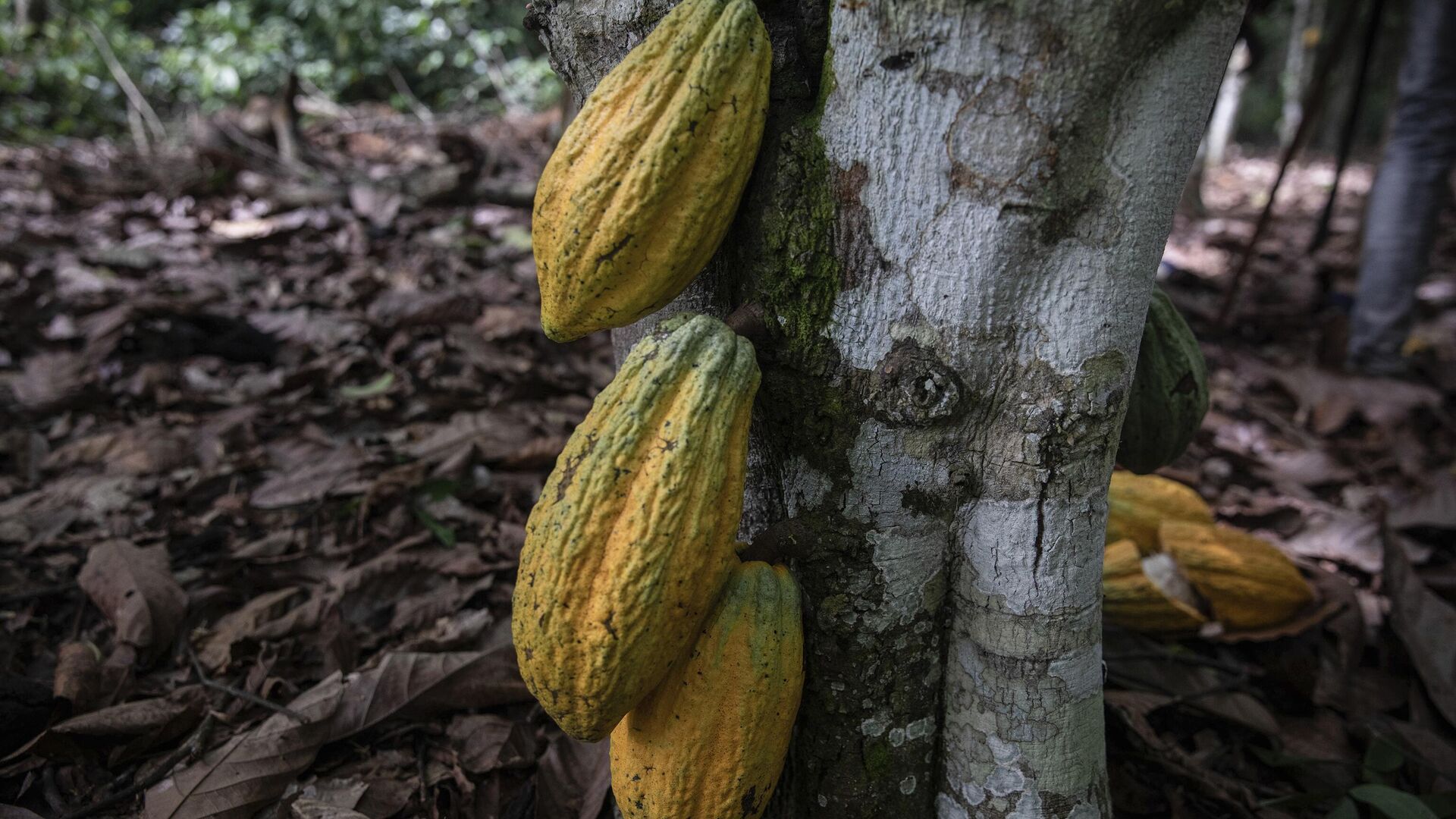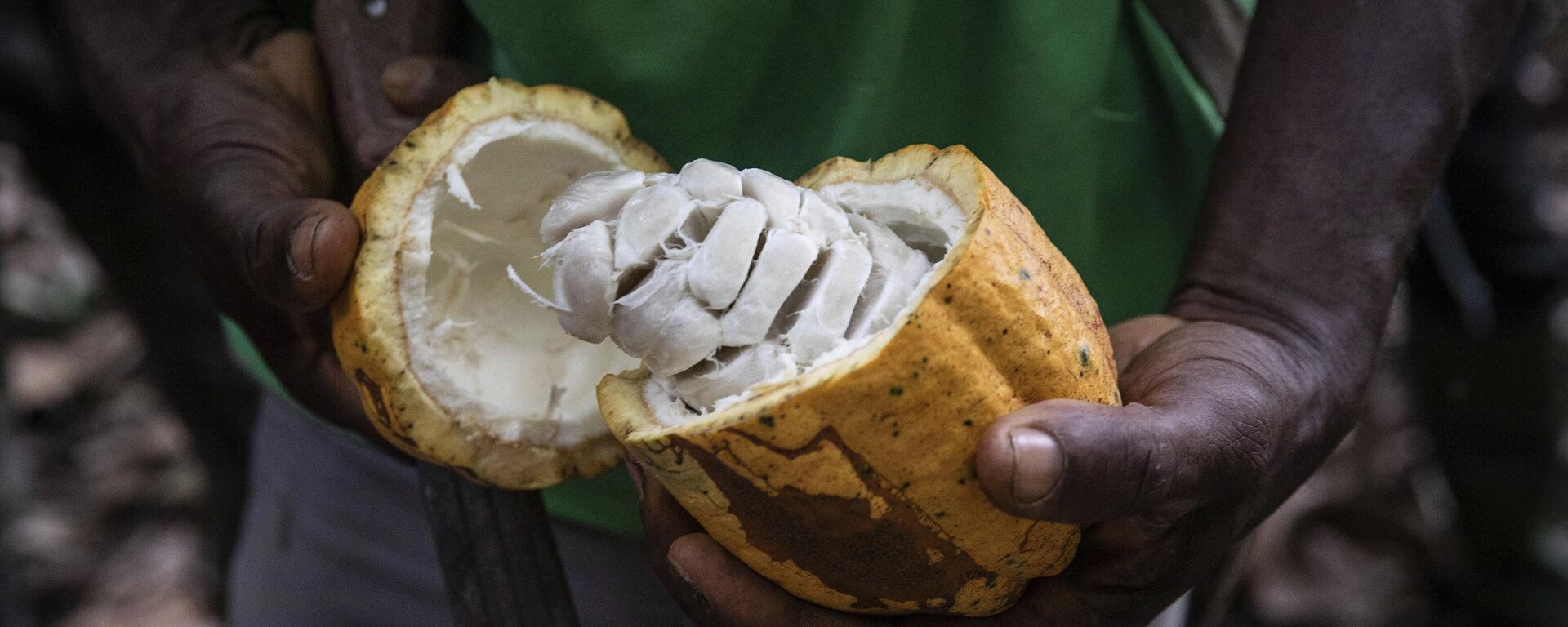https://en.sputniknews.africa/20240719/what-is-swollen-shoot-disease-and-how-it-affects-cocoa-production-1067557960.html
What is Swollen Shoot Disease and How It Affects Cocoa Production?
What is Swollen Shoot Disease and How It Affects Cocoa Production?
Sputnik Africa
The cocoa market is in turmoil, with prices hitting record highs, driven by various challenges affecting key producers in West Africa, particularly Cote... 19.07.2024, Sputnik Africa
2024-07-19T17:38+0200
2024-07-19T17:38+0200
2024-07-22T13:53+0200
features
cocoa
ghana
west africa
cote d'ivoire (ivory coast)
economy
farmers
agriculture
chocolate
https://cdn1.img.sputniknews.africa/img/07e8/07/13/1067559340_0:160:3072:1888_1920x0_80_0_0_690b3a154f2ebaa28071e97c6049599c.jpg
One of Ghana's main cocoa-producing regions is 81% infected with Cocoa Swollen Shoot Virus Disease (CSSVD), the International Cocoa Organization (ICCO) recently reported.The Western North region, the heart of Ghana's cocoa production, spans 410,229 hectares, of which 330,456 hectares are currently affected by the CSSVD. As of the latest reports, CSSVD is also spreading in Cote d'Ivoire, although Ivorian authorities have not yet disclosed the area most impacted by the disease.What is swollen shoot disease, and what risks does it pose to the crop? Sputnik Africa summarized what is known about it.CSSVD is caused by the Cocoa Swollen Shoot Virus, which is a member of the Badnavirus genus. The disease is primarily transmitted by several species of mealybugs, which are small sap-sucking insects. These mealybugs feed on the sap from infected cocoa plants and then transfer the virus to healthy cocoa plants as they move and feed.The disease can cause significant damage to cocoa crops, including:To prevent and manage CSSVD, farmers can use practices such as pruning to remove infected branches, using resistant varieties of cocoa trees, and applying fungicides to control the spread of the fungus.On the latter point, Ghana's cocoa regulator provides farmers in the Volta and Oti regions with pesticides, fungicides, and other chemicals. However, farmers in these areas have reported decreased harvests over the past two seasons, attributing part of the problem to delays in receiving fertilizers and pesticides.A spokesperson from the Ghana Cocoa Board reportedly said that the regulator has sufficient stocks of chemicals. However, they distribute these supplies based on immediate needs to prevent misuse, smuggling, and hoarding among farmers.However, it's not all bad. The ICCO report suggested that while cocoa prices have not yet returned to the typical levels below $5,000 per tonne seen since February, there are optimistic signs for improvement. Factors contributing to the price softening may include reports of favorable weather conditions (timely rains interspersed with sunshine) and aiding crop growth, leading to expectations of a stronger main crop yield in the upcoming 2024/25 cocoa season.
https://en.sputniknews.africa/20240712/ghanaian-cocoa-producers-unveil-bittersweet-truth-behind-chocolate-market-1067473058.html
ghana
west africa
cote d'ivoire (ivory coast)
Sputnik Africa
feedback@sputniknews.com
+74956456601
MIA „Rossiya Segodnya“
2024
Christina Glazkova
https://cdn1.img.sputniknews.africa/img/07e7/0b/07/1063380906_0:0:673:674_100x100_80_0_0_79628b4d0cd9f29291a57aa13bbf9e7a.jpg
Christina Glazkova
https://cdn1.img.sputniknews.africa/img/07e7/0b/07/1063380906_0:0:673:674_100x100_80_0_0_79628b4d0cd9f29291a57aa13bbf9e7a.jpg
News
en_EN
Sputnik Africa
feedback@sputniknews.com
+74956456601
MIA „Rossiya Segodnya“
Sputnik Africa
feedback@sputniknews.com
+74956456601
MIA „Rossiya Segodnya“
Christina Glazkova
https://cdn1.img.sputniknews.africa/img/07e7/0b/07/1063380906_0:0:673:674_100x100_80_0_0_79628b4d0cd9f29291a57aa13bbf9e7a.jpg
cocoa, ghana, west africa, cote d'ivoire (ivory coast), economy, farmers, agriculture, chocolate
cocoa, ghana, west africa, cote d'ivoire (ivory coast), economy, farmers, agriculture, chocolate
What is Swollen Shoot Disease and How It Affects Cocoa Production?
17:38 19.07.2024 (Updated: 13:53 22.07.2024) Christina Glazkova
Writer / Editor
The cocoa market is in turmoil, with prices hitting record highs, driven by various challenges affecting key producers in West Africa, particularly Cote d'Ivoire and Ghana. Although prices have eased slightly since mid-June, they remain significantly elevated, as per ICE Futures data.
One of Ghana's main cocoa-producing regions is 81% infected with Cocoa Swollen Shoot Virus Disease (CSSVD), the International Cocoa Organization (ICCO) recently
reported.The Western North region, the heart of Ghana's cocoa production, spans 410,229 hectares, of which 330,456 hectares are currently affected by the CSSVD. As of the latest reports, CSSVD is also spreading in
Cote d'Ivoire, although Ivorian authorities have not yet disclosed the area most impacted by the disease.
What is swollen shoot disease, and what risks does it pose to the crop? Sputnik Africa summarized what is known about it.
CSSVD is caused by the Cocoa Swollen Shoot Virus, which is a member of the Badnavirus genus. The disease is primarily transmitted by several species of mealybugs, which are small sap-sucking insects. These mealybugs feed on the sap from infected cocoa plants and then transfer the virus to healthy cocoa plants as they move and feed.
The
disease can cause significant damage to cocoa crops, including:
Reduced yields: Infected trees may produce fewer and smaller pods, resulting in lower overall yields;
Decreased quality: Pods from infected trees may contain fewer cocoa beans, and the beans themselves may be smaller and of lower quality;
Increased costs: Treatment and control measures for swollen shoot disease can be expensive, adding to the cost of cocoa production;
Spread of disease: If left untreated, swollen shoot disease can spread rapidly within a cocoa plantation, affecting more trees and causing further damage.
To prevent and manage CSSVD,
farmers can use practices such as pruning to remove infected branches, using resistant varieties of cocoa trees, and applying fungicides to control the spread of the fungus.
On the latter point,
Ghana's cocoa regulator provides farmers in the Volta and Oti regions with pesticides, fungicides, and other chemicals. However, farmers in these areas have reported decreased harvests over the past two seasons, attributing part of the problem to delays in receiving fertilizers and pesticides.
A spokesperson from the Ghana Cocoa Board reportedly said that the regulator has sufficient stocks of chemicals. However, they distribute these supplies based on immediate needs to prevent misuse, smuggling, and hoarding among farmers.
However, it's not all bad. The ICCO report suggested that while cocoa prices have not yet returned to the typical levels below $5,000 per tonne seen since February, there are optimistic signs for improvement. Factors contributing to the price softening may include reports of favorable weather conditions (timely rains interspersed with sunshine) and aiding crop growth, leading to expectations of a stronger main crop yield in the upcoming 2024/25 cocoa season.



